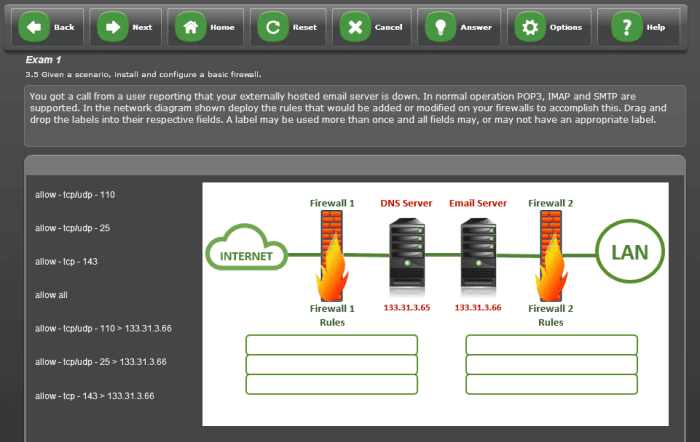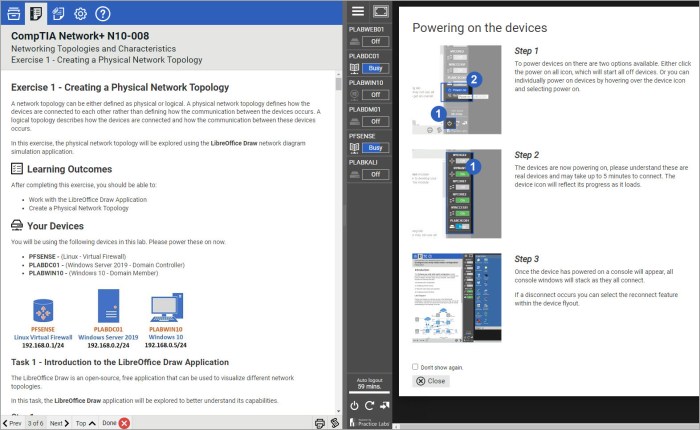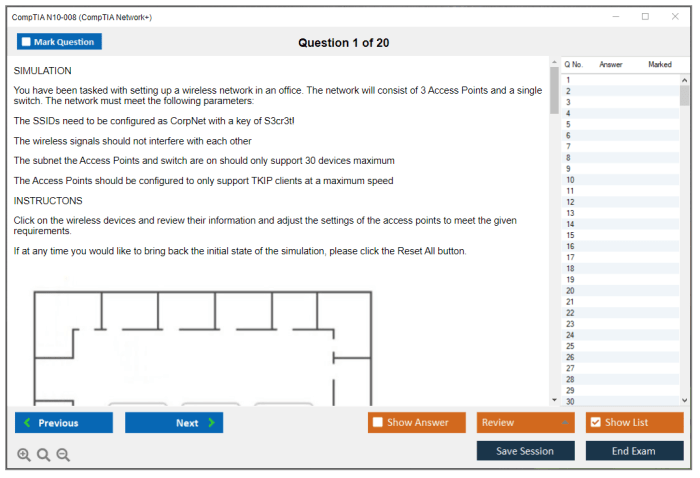Network + practice questions n10-008 – Prepare for the CompTIA Network+ N10-008 certification exam with our comprehensive practice questions. Covering a wide range of network concepts, these questions will challenge your knowledge and help you master the skills required for networking professionals.
From understanding network topologies to configuring wireless networks, this guide will provide you with the foundation you need to succeed in the exam and your career.
Network Concepts

The Open Systems Interconnection (OSI) model is a conceptual framework that defines the different layers of a network. Each layer provides specific functions and services to support communication between devices. The seven layers of the OSI model are:
- Physical layer: Transmits and receives bits over a physical medium.
- Data link layer: Manages the flow of data across the physical layer and detects errors.
- Network layer: Provides addressing and routing services for packets.
- Transport layer: Ensures reliable and efficient delivery of data between devices.
- Session layer: Manages the establishment, maintenance, and termination of sessions.
- Presentation layer: Formats data for the application layer.
- Application layer: Provides services to the user, such as file transfer, email, and web browsing.
Network protocols are sets of rules that govern how devices communicate on a network. Some common network protocols include:
- TCP (Transmission Control Protocol): Provides reliable and ordered delivery of data.
- UDP (User Datagram Protocol): Provides unreliable and unordered delivery of data.
- HTTP (Hypertext Transfer Protocol): Used for web browsing.
- FTP (File Transfer Protocol): Used for transferring files.
- SMTP (Simple Mail Transfer Protocol): Used for sending email.
Network topologies define the physical arrangement of devices on a network. Some common network topologies include:
- Bus topology: All devices are connected to a single cable.
- Ring topology: All devices are connected to each other in a ring.
- Star topology: All devices are connected to a central hub or switch.
- Mesh topology: All devices are connected to each other.
Subnetting

Subnetting is the process of dividing a network into smaller subnetworks. This allows for more efficient use of IP addresses and can improve network performance. To subnet an IP address, you need to know the subnet mask. The subnet mask is a 32-bit number that indicates which bits of the IP address are used for the network address and which bits are used for the host address.
For example, the IP address 192.168.1.100 with a subnet mask of 255.255.255.0 would be divided into the following subnetworks:
| Subnet | Network Address | Broadcast Address | Host Range |
|---|---|---|---|
| 192.168.1.0 | 192.168.1.0 | 192.168.1.255 | 192.168.1.1
|
VLSM (Variable Length Subnet Masking) is a technique that allows for more flexible subnetting. VLSM allows you to create subnetworks of different sizes, which can be useful for optimizing network performance.
Routing
Routing is the process of forwarding packets from one network to another. Routers are devices that perform routing. There are two main types of routing protocols: static and dynamic. Static routing protocols require you to manually configure the routing table on each router.
Dynamic routing protocols automatically learn the network topology and update the routing table accordingly.
Routing table entries contain information about the destination network, the next hop router, and the cost of the path to the destination network. The cost of a path is typically measured in terms of hops, which is the number of routers that a packet must pass through to reach its destination.
When a packet arrives at a router, the router looks up the destination network in the routing table. If there is a match, the router forwards the packet to the next hop router. If there is no match, the router drops the packet.
Switching
Switches are devices that connect multiple devices on a network. Layer 2 switches operate at the data link layer of the OSI model. They use MAC addresses to forward packets. Layer 3 switches operate at the network layer of the OSI model.
They use IP addresses to forward packets.
VLANs (Virtual LANs) are a way to logically segment a network into multiple smaller networks. VLANs can be used to improve security, performance, and management.
There are many different types of switches available, each with its own features and benefits. Some common types of switches include:
- Unmanaged switches: These switches are plug-and-play devices that do not require any configuration.
- Managed switches: These switches allow you to configure a variety of settings, such as VLANs, port security, and traffic prioritization.
- PoE (Power over Ethernet) switches: These switches can provide power to devices over the Ethernet cable, eliminating the need for separate power supplies.
Wireless Networking: Network + Practice Questions N10-008

Wireless networks allow devices to connect to each other without the use of cables. There are two main types of wireless networks: Wi-Fi and cellular networks. Wi-Fi networks are typically used in homes and businesses, while cellular networks are used in mobile devices.
Wireless security is important to protect your network from unauthorized access. There are a number of different wireless security protocols available, such as WPA2 and WPA3.
There are many different wireless standards available, each with its own advantages and disadvantages. Some common wireless standards include:
- 802.11a: Operates in the 5 GHz frequency band and provides high speeds.
- 802.11b: Operates in the 2.4 GHz frequency band and provides lower speeds.
- 802.11g: Operates in the 2.4 GHz frequency band and provides higher speeds than 802.11b.
- 802.11n: Operates in the 2.4 GHz and 5 GHz frequency bands and provides even higher speeds.
- 802.11ac: Operates in the 5 GHz frequency band and provides the highest speeds.
Network Management

Network management is the process of monitoring, maintaining, and troubleshooting networks. Network management tools can help you to identify and resolve network problems, improve performance, and ensure security.
There are a number of different network management tools available, each with its own features and benefits. Some common network management tools include:
- Network monitoring tools: These tools can help you to monitor the performance of your network and identify potential problems.
- Network management systems: These systems provide a centralized way to manage your network, including monitoring, configuration, and troubleshooting.
- Security tools: These tools can help you to protect your network from unauthorized access and attacks.
Network security is an important part of network management. There are a number of different network security measures that you can implement to protect your network, such as:
- Firewalls: These devices can help to block unauthorized access to your network.
- Intrusion detection systems: These systems can help to detect and respond to network attacks.
- Antivirus software: This software can help to protect your network from viruses and other malware.
Questions Often Asked
What is the purpose of these practice questions?
These practice questions are designed to help you prepare for the CompTIA Network+ N10-008 certification exam by testing your knowledge of network concepts.
What topics are covered in these practice questions?
These practice questions cover a wide range of network concepts, including network topologies, routing, switching, wireless networking, and network management.
How many practice questions are included?
The number of practice questions included varies depending on the specific resource or platform you are using.